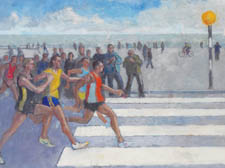|
|
 |
| |

Brighton 10k |
Art that looks on the brighter side of life
While serving with the army, Toby Ward always kept a keen eye out for scenes to fill the sketchpad in his ammunition pouch. Gerald Isaaman previews a new exhibition of his work
AS he patrolled the streets of South Armagh during the dangerous days of the IRA insurrection, army officer Toby Ward kept something special in his ammunition pouch – his sketchbook.
“Thankfully, nothing bad happened to me,” he recalls. “It was in the mid-1980s and quite an exciting experience.
“The only time I got injured was when someone was throwing bricks with one arm and waving the Union Jack with the other. That was funny – and I recorded that when my old regiment asked me to do a few drawings from memory.”
In fact, from his earliest days as a child (he didn’t read until he was eight) he communicated with his amazing ability to sketch anything real or imaginary. “I went to the kind of school where if you were quietly drawing pictures they let you get on with it,” he says.
It is not surprising that he should show such early artistic ability. His paternal grandfather was an art restorer and his father is the celebrated Royal Academician John Ward, in whose studio he worked after leaving school, only to find the ordeal “mercilessly hard and poorly rewarded”.
So it was that he joined the army to see the world, trained at Sandhurst and found himself in strange and uncomfortable places in Europe, ending up in Berlin in 1990.
“Militarily, the Russians had fallen to bits, so there was no real work to do there,” he explains.
“I found myself gradually skiving off to spend more time in Berlin’s fantastic museums,” he says, something which inspired him to rethink a future in the army waiting for his pension when all the time it was his drawing book which heralded the way ahead.
After his six years in service as he went off to study at the City & Guilds of London Art School, where he won the Richard Ford Travel Award that took him off to study in Madrid.
Toby turned out to be an artist who enjoys painting people, as can be seen from an exhibition of 35 of his works at the Catto Gallery in Heath Street, Hampstead.
His work as a portraitist includes a formal picture of the Duke of Edinburgh – “one of the most funny people I’ve ever met,” he insists.
He has also drawn Archbishop Desmond Tutu preaching and former American president Bill Clinton speaking in public at Oxford University – two charismatic people whom he ended up wanting to listen to rather than commit their powerful faces to paper.
Indeed, Toby, now 42, is stimulated most when working as an artist in residence. He has been in the kitchens of London’s Ritz Hotel, behind the scenes at the Royal Opera House, worked with the UN peace-keeping force in Bosnia and at St Martin-in-the-Fields during the redevelopment of the churchyard.
“It suits me well to go somewhere and be part of something,” he confesses. If you are part of some kind of institution, then you are at liberty to nose around and study what is going on slowly, let things happen rather than decide quickly what you are going to draw.”
It is a freedom that commissioned portraits do not provide. “A portrait is always most difficult to make when a sitter in unhappy or when something close to them is wrong, like a divorce,” he says. “If so, their essence is changing, or there’s no essence there at all. All you find to paint is unhappiness.”
That provides a clue to why Toby’s paintings are more of people acutely observed enjoying themselves.
“They’re people passing through life – and a lot of life is passing time,” he points out. “I like people who drink in cheap bars. I like the unfussy pleasure of an evening in an uncomfortable room with two types of beer and a red wine. I like the casual companionship and the passing of time.”
Yet it is a casualness that hides his expertise and talent for painting a world he is intimately part of and aware of in all its subtleties and nuances.
At a time when the world faces wars, dictators and disaster, it is a welcome change to adore the good things in life.
Almost appropriately, Toby lists among his influences artists who have haunted Hampstead’s past, notably Mark Gertler, Stanley Spencer, Ben Nicolson, CWR Nevinson and Christopher Wood, but didn’t appreciate the connection until I pointed it out.
“I used to come up to the Heath on painting expeditions when I was at art school,” he says. “We used to see the places where Constable worked and go to the Holly Bush pub where George Romney had a studio. We would drink a pint in tribute to him.”
Now today’s citizens of Hampstead will have a chance to decide whether Toby too deserves their attention. Their vote should be an overwhelming yes.
|

|
 |
|
 |
|

